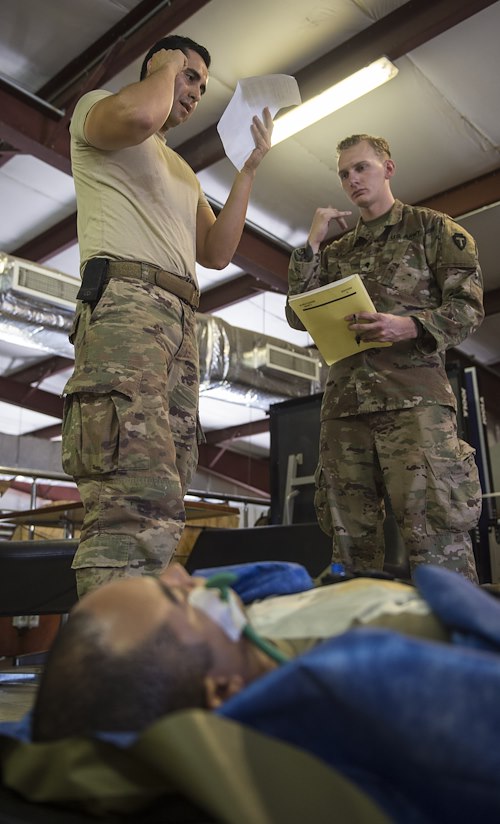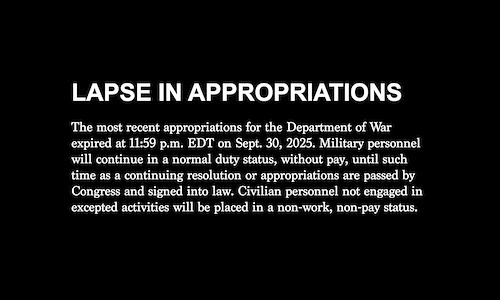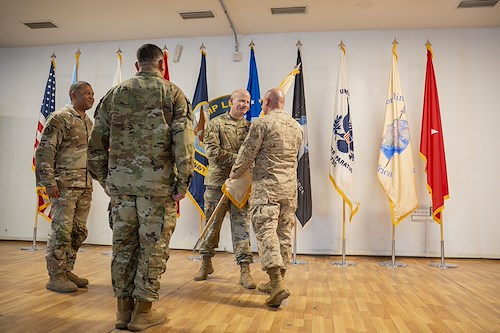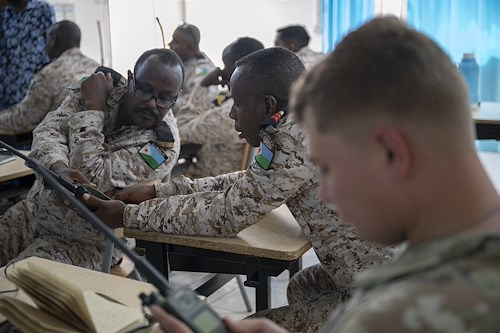Gallery contains 8 images
×
Photo 1 of 8
CJTF-HOA trains to save lives
U.S. Air Force Staff Sgt. Julio Rojas (left), assigned to the 870th Aeromedical Evacuation Squadron, simulates calling for a medical evacuation as U.S. Army Spc. Alexander Kahanek, an instructor assigned to the 3rd Battalion, 144th Infantry Regiment Task Force Bayonet, attached to the Combined Joint Task Force – Horn of Africa, observes the final assessment of a U.S. Army Combat Lifesaver Course held at Camp Lemonnier, Djibouti, Dec. 1, 2017. The five-day course focused on teaching students how to administer lifesaving tactical medical care to wounded service members on the battlefield. (U.S. Air Force photo by Staff Sgt. Timothy Moore)
Photo by: Staff Sgt. Timothy Moore
Photo 2 of 8
CJTF-HOA trains to save lives
U.S. Army Cpl. Michael Pasichnyk, assigned to the 3rd Battalion, 144th Infantry Regiment Task Force Bayonet, attached to the Combined Joint Task Force – Horn of Africa, demonstrates how to insert a nasopharyngeal airway during a U.S. Army Combat Lifesaver Course held at Camp Lemonnier, Djibouti, Nov. 29, 2017. The five-day course focused on teaching students how to administer lifesaving tactical medical care to wounded service members on the battlefield. (U.S. Air Force photo by Staff Sgt. Timothy Moore)
Photo by: Staff Sgt. Timothy Moore
Photo 3 of 8
CJTF-HOA trains to save lives
U.S. Army Staff Sgt. Richard Rye, a combat medic assigned to the 443rd Civil Affairs Detachment, attached to the Combined Joint Task Force – Horn of Africa, simulates an injury during the final assessment of a U.S. Army Combat Lifesaver Course held at Camp Lemonnier, Djibouti, Dec. 1, 2017. The five-day course focused on teaching students how to administer lifesaving tactical medical care to wounded service members on the battlefield. (U.S. Air Force photo by Staff Sgt. Timothy Moore)
Photo by: Staff Sgt. Timothy Moore
Photo 4 of 8
CJTF-HOA trains to save lives
U.S. Army Cpl. Michael Pasichnyk, assigned to 3rd Battalion, 144th Infantry Regiment Task Force Bayonet, attached to the Combined Joint Task Force - Horn of Africa, demonstrates how to perform a needle chest decompression during a U.S. Army Combat Lifesaver Course held at Camp Lemonnier, Djibouti, Nov. 29, 2017. The five-day course focused on teaching students how to administer lifesaving tactical medical care to wounded service members on the battlefield. (U.S. Air Force photo by Staff Sgt. Timothy Moore)
Photo by: Staff Sgt. Timothy Moore
Photo 5 of 8
CJTF-HOA trains to save lives
U.S. Army Cpl. Michael Pasichnyk, assigned to the 3rd Battalion, 144th Infantry Regiment Task Force Bayonet, attached to the Combined Joint Task Force – Horn of Africa, observes U.S. Navy Utilitiesman 3rd Class Amanda Stone, assigned to Naval Mobile Construction Battalion 133, assess a simulated casualty during a U.S. Army Combat Lifesaver Course held at Camp Lemonnier, Djibouti, Nov. 29, 2017. The five-day course focused on teaching students how to administer lifesaving tactical medical care to wounded service members on the battlefield. (U.S. Air Force photo by Staff Sgt. Timothy Moore)
Photo by: Staff Sgt. Timothy Moore
Photo 6 of 8
CJTF-HOA trains to save lives
U.S. Navy Utilitiesman 3rd Class Amanda Stone, assigned to Naval Mobile Construction Battalion 133, attached to the Combined Joint Task Force – Horn of Africa, performs a needle chest decompression (NCD) on a simulated casualty during the final assessment of a U.S. Army Combat Lifesaver Course held at Camp Lemonnier, Djibouti, Dec. 1, 2017. An NCD is used when air enters the chest cavity but can’t escape, creating pressure on a lung. The five-day course focused on teaching students how to administer lifesaving tactical medical care to wounded service members on the battlefield. (U.S. Air Force photo by Staff Sgt. Timothy Moore)
Photo by: Staff Sgt. Timothy Moore
Photo 7 of 8
CJTF-HOA trains to save lives
U.S. Navy Utilitiesman 3rd Class Amanda Stone, assigned to Naval Mobile Construction Battalion 133, attached to the Combined Joint Task Force – Horn of Africa, uses her knee to place force on a pressure point, a technique used to stop bleeding, as she prepares to apply a combat application tourniquet during the final assessment of a U.S. Army Combat Lifesaver Course held at Camp Lemonnier, Djibouti, Dec. 1, 2017. The five-day course focused on teaching students how to administer lifesaving tactical medical care to wounded service members on the battlefield. (U.S. Air Force photo by Staff Sgt. Timothy Moore)
Photo by: Staff Sgt. Timothy Moore
Photo 8 of 8
CJTF-HOA trains to save lives
U.S. Air Force Airman 1st Class Antonio Espinoza, assigned to the Combined Joint Task Force - Horn of Africa Communications Directorate, seals the edges of a simulated open chest wound during the final assessment of a U.S. Army Combat Lifesaver Course held at Camp Lemonnier, Djibouti, Dec. 1, 2017. The five-day course focused on teaching students how to administer lifesaving tactical medical care to wounded service members on the battlefield. (U.S. Air Force photo by Staff Sgt. Timothy Moore)
Photo by: Staff Sgt. Timothy Moore
U.S. Army, Navy, Air Force and Marine Corps service members assigned to the Combined Joint Task Force – Horn of Africa (CJTF-HOA), attended a U.S. Army Combat Lifesaver Course held at Camp Lemonnier, Djibouti from Nov. 27 to Dec. 1, 2017.
The five-day course focused on teaching students how to provide lifesaving tactical medical care to casualties on the battlefield. During the course, students learned how to control bleeding, manage airways, and transport casualties.
“You have a lot of components,” said U.S. Army Staff Sgt. Richard Rye, a combat medic and instructor from the 443rd Civil Affairs Detachment. “You’re just trying to put all the components together in a real-time scenario.”
To help them better prepare for the scenario, the 10 students began by studying the application of each skill in a classroom setting. A follow-on practical exercise allowed them to test those skills in a simulated environment.
“The best part about class was the hands-on portion,” said U.S. Navy Utilitiesman 3rd Class Amanda Stone, assigned to Naval Mobile Construction Battalion 133. “I feel more comfortable that if I was in a combat situation and had to apply first aid, I would feel more competent in my skills and myself now.”
Every student is required to complete the practical exercise to demonstrate knowledge in tactical field medical care as part of the 40 hours of classroom instruction.
The ability to remain focused and correctly assess wounds to administer aid is an important part of the practical exercise.
“The most challenging part of the course is really just keeping your head on,” said U.S. Navy Hospital Corpsman 1st Class Ludwig Williams, a radiology technician assigned to the Camp Lemonnier Expeditionary Medical Facility. “(You) look for bleeding, then you go to airway, and circulation in that order opposed to going for airway (first) in the civilian world. You’ve got to stay focused.”
Students who successfully completed the 40-hour block of instruction and practical exercise are certified Combat Lifesavers.
“Handing them their certificates is the best part,” Rye said. “(It’s) watching them walk in with a basic understanding and have them leave with valuable new skills on how to treat a casualty.”




























